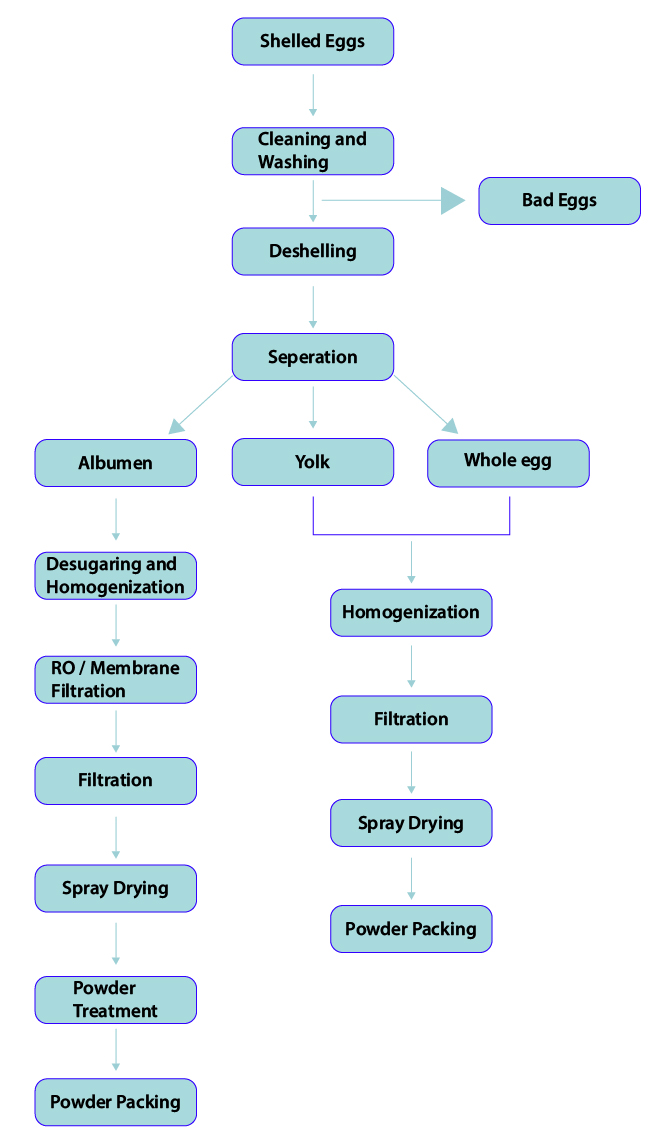Egg Powder Plant

Advantages and Usage of Coconut Milk Powder
- Eggs are nutrient rich, high quality protein, containing 11 different vitamins and minerals, eggs are an easy way to increase nutrient intakes. They’re also one of the few foods containing vitamin D and are economical. All these nutrients are present in Egg powder.
- Egg powder can be completely reconstituted with warm water to have all properties and nutrients present in shelled eggs.
- Egg Powder is a non-perishable commodity while fresh or liquid eggs are perishable foods.
- Egg Powder can have a storage life of 5–10 years depending on the environment.
- The shelf life can further be extended by placing egg powder in air tight containers under anaerobic conditions or placed in a cool storage place. There is no need for any refrigeration or cold chain as in case of liquid eggs.
- In case of powdered eggs there is no chance of contamination from the breakage of shells. Fresh eggs are always feared of contamination.
- Storage of fresh eggs requires special instruction regarding handling and stacking in the warehouses from country to country, which is not there in case of powdered eggs.
- Storage space required for egg powder is 75% less than the fresh shelled eggs.
- Egg Powder transportation will take 60% less transport cost than the fresh eggs.
- It is preferably used by food manufacturers because of easy handling and storing properties coupled with a low price.
- Considering the nutritional and therapeutic benefits and availability of egg powder available for diverse food applications, the use of eggs and egg products in daily life should be increased in order to cope with calories and protein deficiency issues around the globe.
Process Description:

1 Egg Cleaning and Inspection Machine
This is a conveyor machine immersed in water. The Eggs keep floating due to buoyancy force
and travels from one end to another end. During this treatment all muddy particles cling to
eggs are socked in water (with treatment solution) and made loose. On the same conveyor
disinfection by spraying liquid can be done at discretion of end user.
The Socked eggs are passed to brush cleaner which removes all the cling particles and dirt
from the eggs and liquid is sprayed to dissolve and carry this dirt.
The eggs travel to next operation during travelling they are impinged with warm air for
removing the moisture from surface and make them residue free. Further it is transferred
through candles where workers can remove broken eggs, foul eggs etc.

2. Egg Deshelling machine
Egg breaking equipment which is installed with egg breaking knife keeps on rotating. The travelling eggs arrives at the loading position where eggs are picked up in a small bowl having size equivalent to egg size and broken with the knife while rotating further. Broken egg contents come out of the eggshells and fall down onto the egg white and egg yolk separating part, Finally, egg white enter egg white collecting container and egg yolk enter egg yolk collecting container.

3. Feed Preparation:
Extracted egg liquid like white albumen, yolk and Whole egg is further used as raw feed to Slurry / Emulsion Preparation section. This is a simple process which involves mixing of various ingredients in a proper proportion by auto weighing system in case of special formulations. The large tanks with specially designed efficiently mixing and blending agitator arrangement are provided to mix the ingredients. The tanks are also provided with the heating arrangement so as to maintain proper temperature for producing right slurry formulation depending on the ingredients. The feed is homogenized in a specially designed high-pressure homogenizer.

4. Pasteurization and De-sugaring:
Homogenized egg liquid is passed through pasteurizer for deactivating Salmonella contamination in it. Pasteurization is the disinfection process of bacteria at low temperature and in a certain time frame. Based on the standards issued by the NSW Food Authority, liquid whole egg has to be pasteurized first in low temperature plate heat exchanger and then in high temperature plate heat exchanger. Pasteurized liquid is treated with either enzymes or surfactants to deactivate the glucose present in the egg white or whole egg liquid. Glucose needs to be removed from egg whites to avoid the issue of caramelization and Maillard reaction and ensure a good stabilized product.

5. Spray Drying:
The feed is then dried to powder form in a spray dryer. The feed is atomized to fine droplets in a large spray chamber by using either disc atomizer or series of high-pressure nozzles. These atomized particles come in contact with hot air and water in it gets evaporated. The dried product is discharged at the bottom of chamber. The dried product entrained with the exhaust air is separated in a high efficiency cyclone separator. The exhaust air is further passed through a secondary cyclone separator or a bag house for recovering the fines not separated in primary cyclone. Clean air is then vented to the atmosphere. The entire operation of the plant is monitored and controlled through a locally mounted control panel or through PLC as per customer choice.

6. Storage and Packing:
In case of Albumen the powder is treated with heat before packing. Product is cooled and in a pneumatic conveying system or Screw Cooler and then passed on to packing machine hopper, where it is continuously packed.

Features:
- Low temperature drying which maintains the qualities and retains the nutrients of the original egg.
- cGMP construction of equipment to maintain high hygiene level.
- Fully automatic, compact and energy efficient system to ensure smooth and ease of operation.
- Plant foot print is planned as per availability of land from customer.
- Complete sanitary design with CIP system